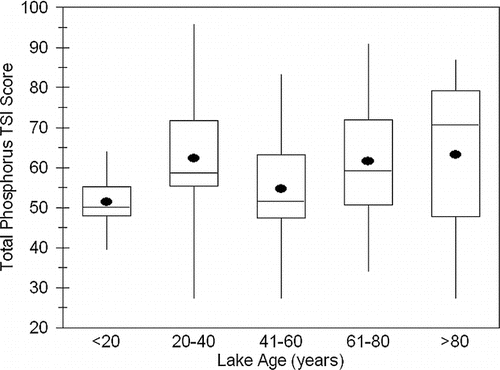Figures & data
Figure 1 Approximate locations of the 44 Kansas study lakes. Open circles = newer lakes/unimpacted watersheds. Black circles = older lakes/unimpacted watersheds. Open triangles = newer lakes/impacted watersheds. Black triangles = older lakes/impacted watersheds.
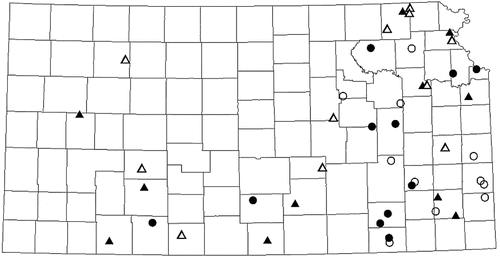
Table 1 Pearson correlations (R) among physical and water quality features, utilizing the final candidate list of 102 lake/watershed units. Significant (P ⩽ 0.05) correlations are shaded. All data, except watershed land use (portion in cropland or urban land) and lake age, used Log10 transformations to achieve normality. Watershed land use composition used a square-root transformation, while lake age did not require transformation of the data.
Table 2a Descriptive statistics for lake/watershed group “Newer Artificial Lakes in Unimpacted Watersheds.” N = 11 lake/watershed units.
Table 2b Descriptive statistics for lake/watershed group “Newer Artificial Lakes in Impacted Watersheds.” N = 11 lake/watershed units.
Table 2c Descriptive statistics for lake/watershed group “Older Artificial Lakes in Unimpacted Watersheds.” N = 11 lake/watershed units.
Table 2d Descriptive statistics for lake/watershed group “Older Artificial Lakes in Impacted Watersheds.” N = 11 lake/watershed units.
Table 3 Kruskal-Wallace test results (H) for inter-group comparisons for lake/watershed physical features and general water chemistry parameters. NU = newer artificial lakes in unimpacted watersheds; NX = newer artificial lakes in impacted watersheds; OU = older artificial lakes in unimpacted watersheds; and OX = older artificial lakes in impacted watersheds. Shaded results indicate statistically significant differences between group pairs (P ⩽ 0.05).
Table 4 Kruskal-Wallace test results (H) for inter-group comparisons for lake/watershed nutrient and trophic state parameters. NU = newer artificial lakes in unimpacted watersheds; NX = newer artificial lakes in impacted watersheds; OU = older artificial lakes in unimpacted watersheds; and OX = older artificial lakes in impacted watersheds. Shaded results indicate statistically significant differences between group pairs (P ⩽ 0.05).
Figure 2 Percentage of surveyed lakes with a period-of-record trophic state classification of mesotrophic (TSIChl-a < 50), lower eutrophic (TSIChl-a 50–54.9), eutrophic (TSIChl-a 55–59.9), upper eutrophic (TSIChl-a 60–63.9), or hypereutrophic (TSIChl-a ⩾ 64), versus the percent of watershed land under cultivation.
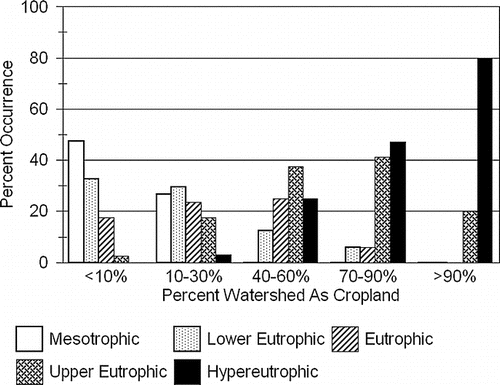
Figure 3 Box plots depicting period-of-record mean Carlson trophic state index (TSI) scores based on chlorophyll-a versus watershed classes based on the proportion of cropland in the drainage. Whiskers represent the maximum and minimum values, the central box the interquartile range and the median, and the black circle the mean. TSI-to-chlorophyll-a correspondences: 50 = 7.2 μg·L−1, 60 = 20.1 μg·L−1, 70 = 55.7 μg·L−1, and 80 = 154.3 μg·L−1.
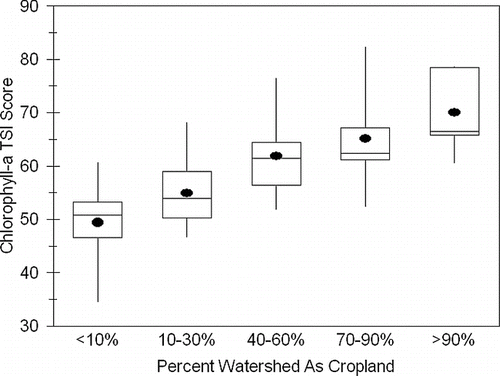
Figure 4 Box plots depicting period of record mean Carlson trophic state index (TSI) scores based on total phosphorus versus watershed classes based on the proportion of cropland in the drainage. Whiskers represent the maximum and minimum values, the central box the interquartile range and the median, and the black circle the mean. TSI-to-total phosphorus correspondences: 50 = 24 μg·L−1, 60 = 48 μg·L−1, 70 = 96 μg·L−1, and 80 = 192 μg·L−1.
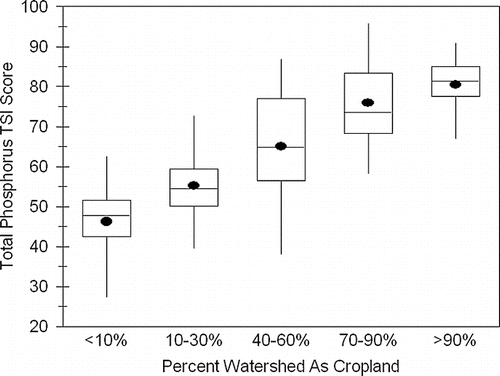
Figure 5 Box plots depicting period-of-record mean Carlson trophic state index (TSI) scores based on chlorophyll-a versus lake age classes based on the years since dam completion. Whiskers represent the maximum and minimum values, the central box the interquartile range and the median, and the black circle the mean. TSI-to-chlorophyll-a correspondences: 50 = 7.2 μg·L−1, 60 = 20.1 μg·L−1, 70 = 55.7 μg·L−1, and 80 = 154.3 μg·L−1.
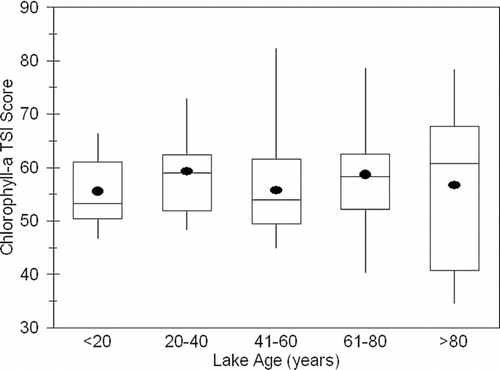
Figure 6 Box plots depicting period of record mean Carlson trophic state index (TSI) scores based on total phosphorus versus lake age classes based on the years since dam completion. Whiskers represent the maximum and minimum values, the central box the interquartile range and the median, and the black circle the mean. TSI-to-total phosphorus correspondences: 50 = 24 μg·L−1, 60 = 48 μg·L−1, 70 = 96 μg·L−1, and 80 = 192 μg·L−1.
